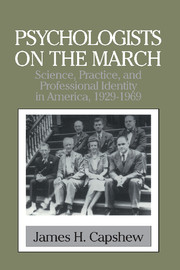Book contents
- Frontmatter
- Contents
- Acknowledgments
- List of Abbreviations
- Introduction: The Psychologists' War
- Interlude I
- 1 Growing Pains: After the Great War
- 2 Mobilizing for World War II: From National Defense to Professional Unity
- 3 Home Fires: Female Psychologists and the Politics of Gender
- Interlude II
- 4 Sorting Soldiers: Psychology as Personnel Management
- 5 Applied Human Relations: The Utility of Social Psychology
- 6 From the Margins: Making the Clinical Connection
- 7 Engineering Behavior: Applied Experimental Psychology
- Interlude III
- 8 A New Order: Postwar Support for Psychology
- 9 Remodeling the Academic Home
- Interlude IV
- 10 The Mirror of Practice: Toward a Reflexive Science
- 11 Beyond the Laboratory: Giving Psychology Away
- Interlude V
- Epilogue: Science in Search of Self
- Index
Introduction: The Psychologists' War
Published online by Cambridge University Press: 06 July 2010
- Frontmatter
- Contents
- Acknowledgments
- List of Abbreviations
- Introduction: The Psychologists' War
- Interlude I
- 1 Growing Pains: After the Great War
- 2 Mobilizing for World War II: From National Defense to Professional Unity
- 3 Home Fires: Female Psychologists and the Politics of Gender
- Interlude II
- 4 Sorting Soldiers: Psychology as Personnel Management
- 5 Applied Human Relations: The Utility of Social Psychology
- 6 From the Margins: Making the Clinical Connection
- 7 Engineering Behavior: Applied Experimental Psychology
- Interlude III
- 8 A New Order: Postwar Support for Psychology
- 9 Remodeling the Academic Home
- Interlude IV
- 10 The Mirror of Practice: Toward a Reflexive Science
- 11 Beyond the Laboratory: Giving Psychology Away
- Interlude V
- Epilogue: Science in Search of Self
- Index
Summary
At the turn of the twentieth century America's foremost psychologist held out the hope that perhaps the “moral equivalent of war” could be found to redirect human energy away from destructive purposes into more positive channels. William James died in 1910 and thus was spared the experiencing of two world wars that gave the lie to the dream he so eloquently expressed. One can only wonder what his reaction would have been to the fact that those global conflicts were not only fought with the aid of tools provided by his fellow psychologists but that they stimulated and shaped the discipline he did so much to establish.
After modest but steady growth from the late nineteenth century, when it was first introduced into American colleges and universities, the field of psychology boomed after the First World War. Between 1919 and 1939 the number of psychologists grew tenfold, from approximately three hundred to three thousand professionals. The Second World War had an even more dramatic and enduring impact. The psychology community had expanded by another order of magnitude by 1970, with more than thirty thousand professionals registered as members of the American Psychological Association. In 1995, fifty years after the end of World War II, the number of psychologists in the United States was approaching a quarter of a million.
- Type
- Chapter
- Information
- Psychologists on the MarchScience, Practice, and Professional Identity in America, 1929–1969, pp. 1 - 8Publisher: Cambridge University PressPrint publication year: 1999

